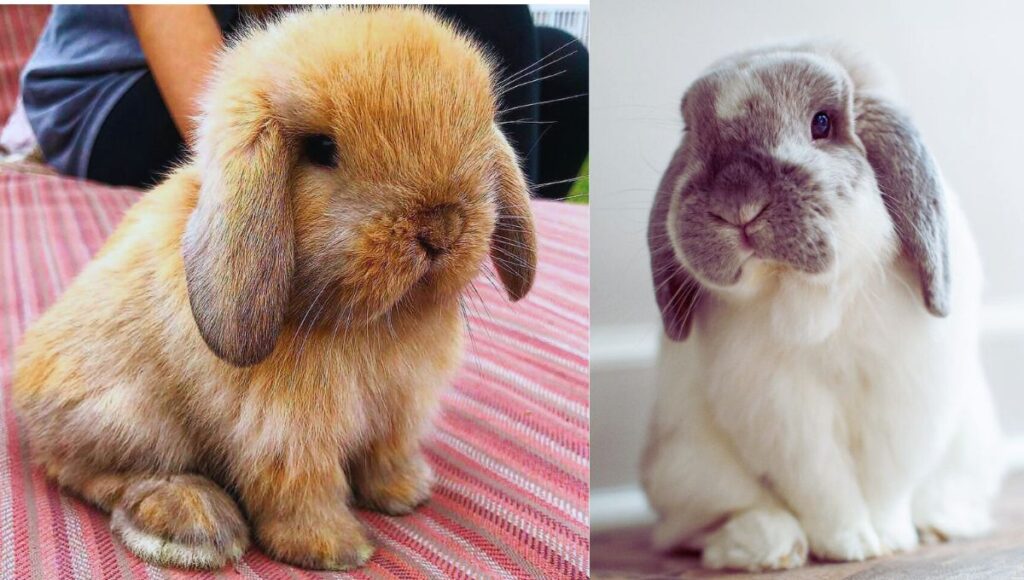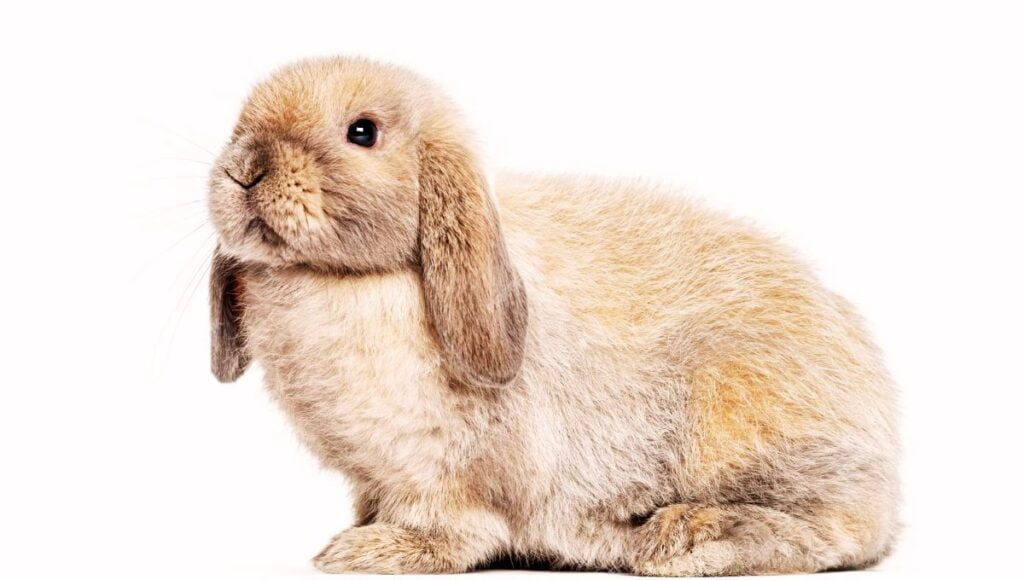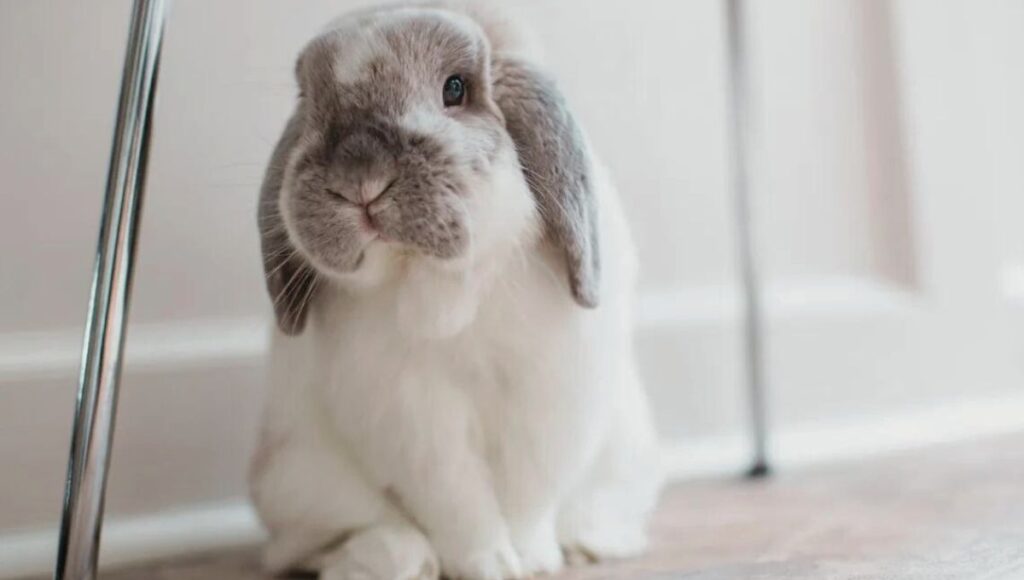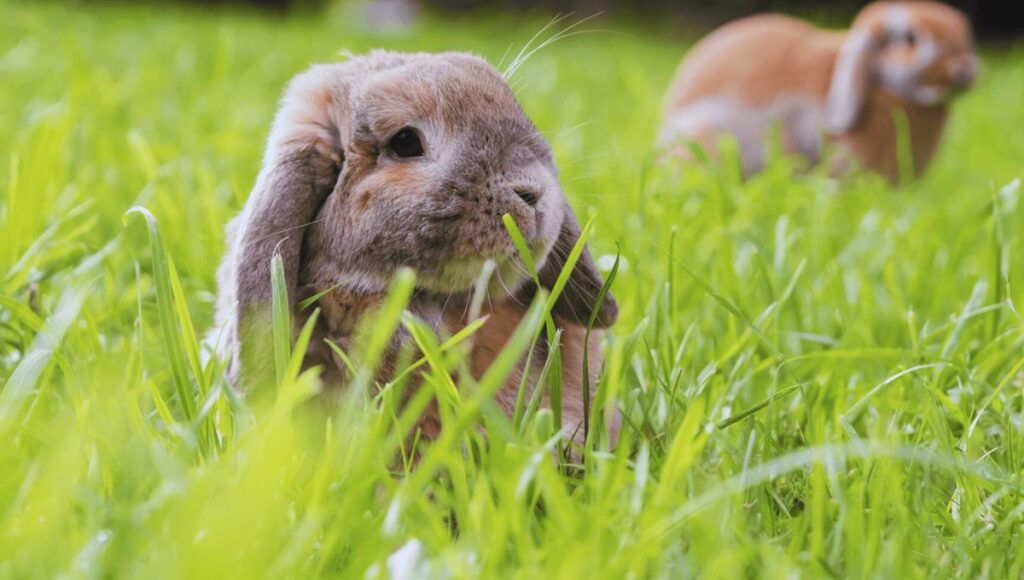The Mini Lop rabbit is one of the domestic dwarf rabbit breeds recognized by the American Rabbit Breeders Association (ARBA). However, it is different from the miniature lop rabbit breed which is recognized by the British Rabbit Council (BRC). However, Mini Lop is considered among the dwarf breeds but it is different from the dwarf lop breeds.

Table of Contents
Mini Lop Rabbits- in a Glimpse:
| Common Name | Mini Lop Rabbits |
| Scientific Name | Oryctolagus cuniculus |
| Other Names | Klein Widder |
| Adult Weight | 3 – 6.5 lbs |
| Colours | Black, Lynx, White, Opal, Chinchilla, etc. |
| Habitat | Cage, hutches, meadows |
| Diet | Grass, Hays, Oats, Spinach, etc |
| Predators | Dogs, cats, foxes, badgers, etc |
| IUCN Status | Not evaluated |
| Gestation Period | 28-31 days |
| Weaning Age | 1.5-2 months |
| Lifespan | 5-10 Years |
| Behaviour | Docile, gentle, playful, and intelligent |
| Good Pets? | Yes |
| Jump | 3 feet |
| Speed | 30 mph |
Everything About Mini Lop Rabbits:
Mini Lop rabbits are often known as basketball with a head as the judges of the rabbit show love to see a Mini Lop that has a well-rounded body with thick furs, long thick ears and a wide head. According to ARBA, the Schedule of points of Standard of Perfection for a Mini Lop are:
General Type 80
- Body 43
- Head 20
- Ears and crown 12
- Feet, Legs & Bone 5
- Fur 10
- Colour & Markings 5
- Condition 5.
Origin:

Mini Lop rabbits are one of the modern rabbit breeds that were discovered by Bob Herschbach at a German National Rabbit Show in Essen, Germany in 1972. At that time, it was known as Klein Widder and it was a cross of German Big Lop and the small Chinchilla.
In 1974, Herschbach’s Mini Lop rabbits debuted at an American Rabbit Breeders’ Association (ARBA) convention held in Ventura, California. But the breed was almost weighing around 8 lbs 3.6 kg and to more compact, attractive and downsize it, Herschbach was helped by other local breeders to breed more of his Mini Lops. The name of the final result was changed to “Mini Lop” from “Klein Widders” to make the breed more appealing to the people.
Habitat:
As the rabbit breed is mostly domestic, they usually live in cages or hutches on the ground. Mini lops are defined as medium-sized dwarf breeds and hence the owner needs enough space in his ground so the rabbit can play, run, jump, and dig.
Physical Appearances: How do you identify a Mini Lop Rabbit?

Sexual dimorphism is present in the breed and Bucks are bigger than the does. According to ARBA, the standard size for a senior buck (6 months or older), weighs around 4.5 to 6.5 pounds (2 to 3 kg). The Senior Does (6 months or older) and the junior rabbits (less than 6 months old) weigh around 3 to 6 pounds (1.4 to 2.7 kg). However, it is also reported that the maximum weight of a Mini Lop was 6.5 lbs (3kg) and the ideal weight is 5.5 lbs or 2.5 kg.
Their body is compact, round and heavily muscular. Their neck is very short, their head is wide and their ears are lopped and hang on either side of their face.
Fur and Colours:
The fur of the Mini Lop rabbit is dense, medium-length and rollback, which means it returns to the original position when it is stroked from the opposite direction. The length of their soft and glossy fur is 3-4 cm.
The Colour of Mini Lop rabbits is divided into two categories: solid and broken. However, there are many colours available for the breed but only a few of them are accepted by the ARBA. Some of the colours are:
Blue, Chestnut Agouti, Ruby-Eyed White, Chocolate, Black, Lynx, White, Opal, Chinchilla, Orange, and Lilac.
Diets:

The exact amount of food that a Mini Lop require depends on many factors such as its age, gender, size, and activity level. But make sure 70-75% of its diet should be hay. Hay is very important for their diet as it helps to improve their digestive system and also helps to wear down their teeth so they are less prone to dental issues.
Apart from hay, you should give them enough amount of green grass, vegetables (such as spinach, parsley, beans, broccoli, and other low-sugar foods), and a sufficient amount of fresh water. However, you can also provide your Mini Lop with commercially packaged rabbit foods but you can’t ignore hay.
Also Read: Lionhead Rabbits: Everything You Must Know Before Buying
Predators and Threats:
Mini Lop rabbits don’t have any natural predators. However, dogs, cats, foxes, badgers, weasels, coyotes, and larger birds can hunt them for their delicious meats. Hence, while playing outdoors, owners must supervise their rabbits closely.
Conservation Status:
However, Mini Lops are a comparatively new breed and have existed for only 50 years but managed to become one of the most popular pet rabbits around the world. Despite their popularity, the exact population of the rabbits is unknown and hence IUCN hasn’t evaluated Mini Lops.
Reproduction:

Mini Lop rabbits reach sexual maturity at 5-6 months old. In the wild, the rabbits are polygynous as the buck mates with several dogs and it is the same for domestic pets too. The breeders usually take the does to the buck’s cage to prevent fighting and the breeding season takes place at quick succession to increase the chance of pregnancy.
The average gestation period for the Mini Lops is 28-31 days and the kittens are born hairless and blind. The litter size is between 3-8 and kittens live solely on their mother’s milk for the first two weeks. After that, the baby rabbits start to eat grass, drink water and fully wean themselves at 1.5- 2 months old.
Lifespan:
Mini Lop rabbits usually live 5-10 years depending on their health, diet and other factors. On average they live around 7-8 years and sometimes they live up to 12 years. The rabbits usually suffer from digestive issues, balance issues, respiratory diseases, uterine cancer, and malocclusion.
Behaviour: Are Mini Lop Rabbits Good Pets?

Mini Lops are known for their wonderful temperament. Like other domestic rabbit breeds, Mini Lops also want to be cuddled and petted. The rabbits don’t like to be stuck inside the cage or hutch all day. They need enough attention and playing time with the owner. If they don’t get it, they might cause trouble and even they can bite.
They are wonderful laid-back rabbits for your family, even with children. The rabbit bonds easily with the members of the family irrespective of their age, experience, and gender. They often love to exercise and play with toys and also invite you to join them while playing. However, you have to make sure that the rabbit gets at least 3-4 hours of playing and running time in the garden to stay fit and healthy.
These rabbits are very intelligent and trainable. You can easily give them litter and potty training, but you have to be patient with the rabbits. You can keep the rabbit indoors as well as outdoors but while keeping outdoors make sure your rabbit is in a cage or hutch so predators cannot harm them. The cage or hutch for the rabbit must be large enough so the Mini Lop can easily move around and play.
Speed and Jump:
Mini Lop rabbits can run at a speed of 30 mph or 48 kmph. However, if needed they can run at a speed of 40-45 mph (65-73 kmph). Most of the Mini Lops cannot achieve top speed as they usually run in a zig-zag fashion to avoid predators. However, depending on their size and activity level, mini-lop rabbits can jump more than 2 feet (61 cm).
Mini Lop Rabbits Sale: How to purchase a Mini Lop?
Mini Lops are one of the most popular domestic rabbit breeds around the world. You can easily find them at your local pet shops or you can buy them from local rabbit breeders easily. Depending on your location, you can purchase them online as well. If you are unable to find a local breeder, you can click here to find a breeder and you can contact them through website, phone, or email.
What is the price of a Mini Lop rabbit?
The price varies depending on location. However, you can find a Mini Lop within $100 almost everywhere. However, you also need to make a one-time investment in cages, hutches, beds, brushes, litter boxes, toys, bowls, etc which may cost around $300-$1000. Also, you need to insure your pet rabbit and invest in health care, which might cost an additional $100.
Cage Size for Mini Lop Rabbits:
The bigger cage is the better cage for a Mini Lop. The rabbit breed is very active and playful and hence they don’t like to be stuck in a cramped space where they can’t move, play, or exercise.
It is recommended that the cage should be at least three to four times the rabbit’s size, or the size of the cage should be at least 24” *36”. The ideal size for the cage is 30” * 36”. However, you can buy multi-story hutches as they provide more space for the bunnies.
7 Facts to Remember Before Purchasing a Mini Lop:
- Despite their soft and wonderful coat, the rabbits don’t need much grooming. If you groom them once a week, it is enough. However, during moulting season, it is advised to groom them twice or thrice a week to maintain their good condition and to prevent matting.
- Never allow your Mini Lop to consume meats or dairy products as it will create problems in the digestive system. Don’t bathe your rabbit, as it could be a traumatic experience for them. Only bathe your rabbit if the rabbit is too dirty. You should also trim their nails when needed.
- Mini Lops love to chew whatever they find on the floor. Hence, try to make the room rabbit-proof. Always check if there is no sharp object present on the floor. Electric wires, important documents, clothes and other important objects should be out of rabbit’s reach.
- You need to buy a soft bed for the rabbit and always check if the surface of the cage is not rough, otherwise, it might irritate the rabbit’s soft paw.
- Mini Lop rabbits are prone to diseases such as Malocclusion (when the upper and lower teeth are misaligned), GI Stasis (the digestive system slows down or stops completely), Ear Mites (Parasite attack the rabbits and rabbits shake their head always), Wool block (rabbit can ingest fur which can become trapped inside the digestive system and create a furball), Flystrike (when flies lay their eggs on soiled patches of fur), respiratory diseases, uterine cancer etc.
- To avoid the above-written disease and keep the rabbit healthy, the owner must take the rabbit to a veterinary surgeon once in six months. However, when reaching five years of age, it is advised to take the rabbits to the surgeon once every three months as the chances of disease increase at that age.
- These rabbits demand a lot of attention from the owners and other family members. They often appeal to the owner to play with them. If they are being ignored for a long time, they can bite and cause trouble. They also need three to four hours to run, jump, dig, and play outdoors. While playing outdoors, you should monitor the rabbit closely, otherwise, predators can harm the rabbit for its delicious meat.
FAQs:
Are Mini Lop Rabbits Aggressive?
In general, Mini Lops are not aggressive. But, when they are afraid or provoked, they can bite. Apart from that, during mating season and if injured the rabbits may show some aggressiveness, especially the females.
What are the differences between Holland Lop and Mini Lop rabbits?
Mini Lop rabbits are a little bigger than Holland Lop. The Mini Lops weigh around 3-6.5 lbs whereas Holland Lops weigh 4 lbs. However, the average height of a Holland Lop is a little bigger than a Mini Lop. Mini Lops have a bigger Lifespan (5-10 years) than the Holland Lops (5-7 years).
However, both the rabbits are known for their calmness, intelligence, and gentleness but Mini Lop rabbits are more docile, mellow, and relaxed than the Holland Lops.
References: Wikipedia
Also Read:
Tan Rabbits Pet Guide: Top 7 Facts to Know Before Buying
Are Polish Rabbits Good Pets? 13 Interesting Facts to Know Before Purchasing
Are Satin Rabbits Good Pets? 17 Facts to Remember Before Purchasing a Satin
Are Rex Rabbits Good Pets? 13 Facts You Should Know Before Purchasing a Rex
English Spot Rabbit: Everything You Should Know Before Purchasing